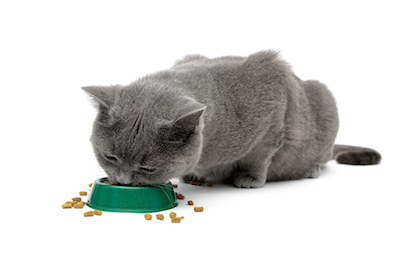Low Carb for Cats

According to Dr. Debra L. Zoran, a clinical assistant professor of Small Animal Medicine and Surgery at Texas A&M University College of Veterinary Medicine & Biomedical Sciences, cats are metabolically adapted for higher protein, low-carbohydrate diets.
“More than 35 percent of cats in the United States are overweight or obese,” said Zoran.
Age, sex, and activity level are all factors that influence the weight of a cat; however, feeding style is a significant contributor to obesity rates. Traditional weight loss plans include low-fat, high-carbohydrate foods. However, cats are not traditional animals when it comes to their ideal diet.
“Cats are not only carnivores but they are obligate carnivores, meaning they require additional protein and other nutrients that are only present in animal tissue”, said Zoran.
Zoran explained that cats utilize protein for energy, even in the face of large amounts of carbohydrates in the diet.
“Because cats lack salivary amylase and have low concentrations of other carbohydrate-digesting enzymes, digestion of sugars is very inefficient in cats,” explained Zoran. “When it comes to cat food, extra carbohydrates only mean extra calories, which, if not burned for energy, are stored as fat.”
In addition to their enzyme deficiencies, a cat’s small intestine is much shorter than that of an equally sized omnivore such as a dog. Felines have longer GI tracts which allow them to handle complex carbohydrates.
Instead of slimming down a fat cat, a high carbohydrate, high fiber diet may lead to abnormal intestinal function or even diarrhea.
“While these [low-fat, high carbohydrate, high fiber] diets may result in weight loss, they do so to the detriment of lean body mass which is protein in muscles,” said Zoran. “Losing lean body mass often contributes to weight regain because cats’ appetites are not reduced and satiety, or a sense of satisfaction, is never reached.”
Past studies evaluating the use of a canned low carb, high-protein (45 percent or higher) diet for weight loss in cats has revealed that all cats lost weight and maintained lean body mass.
“These diets not only resulted in sustained weight loss in these cats, but also in normalization of appetite because they are satiated,” explained Zoran.
This does not mean that cat owners need to bake some blackened tilapia for Tiger or slap some ribs on the grill. A high-protein diet for your cat does not call for extra fuss; suitable foods can be found in the pet food aisle.
“The best commercial diets for achieving a high protein, low-carb profile are canned foods like those used for growth, such as kitten foods, or canned diets specially designed for adult diabetic cats,” said Zoran.
Some cats will turn their noses up at the sight of canned food, but no worries, there are also dry food options that provide high-protein and low-carbohydrate nutrition. However, Zoran recommends that most cats be fed at least some canned food as part of their diet to reduce both carbohydrate intake and overall caloric intake.
“Dry foods tend to be very calorie dense,” said Zoran, “Feeding them only 50 percent canned food is a good starting point.”
Sadly Garfield might need to give up his lasagna dinners for a healthy serving of protein instead.
Pet Talk is a service of the College of Veterinary Medicine & Biomedical Sciences, Texas A&M University. Stories can be viewed on the Web at vetmed.tamu.edu/news/pet-talk. Suggestions for future topics may be directed to editor@cvm.tamu.edu.


